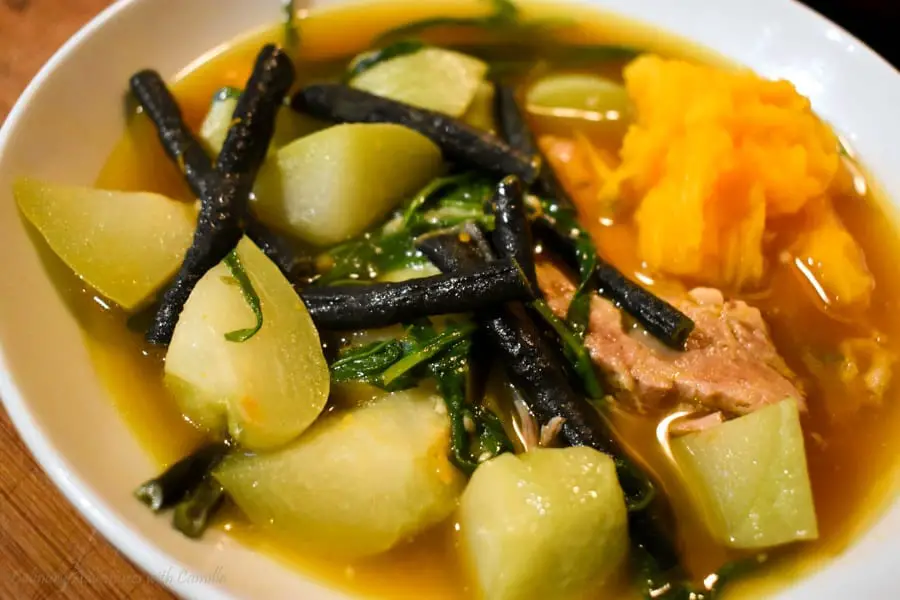Genuine Filipino Food Recipes to Try at Home
Exploring authentic Filipino food dishes presents a chance to appreciate the elaborate tastes and cultural significance behind each recipe. Making use of fresh, regional ingredients is necessary, as is accepting public dining-- a characteristic of Filipino culture.
Popular Filipino Dishes
Filipino food flaunts a rich tapestry of flavors and practices, with over a loads iconic dishes that highlight the nation's diverse social impacts. Among one of the most well-known recipes is Adobo, a tasty stew typically made with poultry or pork, marinated in vinegar, soy sauce, garlic, and spices. Its appetizing flavor account makes it a staple in Filipino households.
Another beloved recipe is Sinigang, a sour soup often made with tamarind, tomatoes, and numerous vegetables. This meal can feature pork, shrimp, or fish, and its rejuvenating preference is ideal for warm climates. For those with a sweet tooth, Leche Flan-- a luscious sugar custard-- functions as a prominent dessert, showcasing the Filipino penchant for rich, sweet tastes.
Kare-Kare, a hearty oxtail stew with a thick peanut sauce, in addition to the famous lumpia, or spring rolls, even more exhibit the variety found in Filipino cuisine. Each meal not just supplies distinct tastes however likewise informs a tale of regional active ingredients and historical impacts, making Filipino food a vibrant representation of its society and heritage.
Essential Active Ingredients for Filipino Food Preparation
The significance of Filipino cooking lies in its necessary ingredients, which function as the foundation for the nation's beloved meals. A variety of flavors and textures collaborated, showcasing the diverse cultural impacts that shape Filipino cuisine.
Secret active ingredients consist of rice, the staple that accompanies almost every meal, symbolizing nourishment and community. Soy sauce, vinegar, and fish sauce (patis) are important for flavoring, imparting umami and depth to dishes. Fresh herbs like cilantro and basil include aromatic freshness, while garlic, onion, and ginger provide a robust taste base.
Protein resources such as pork, hen, and seafood are central to lots of dishes, typically marinated to boost taste. Vegetables like eggplant, bitter melon, and eco-friendly beans add crucial nutrients and balance - Filipino food recipes. Coconut milk is one more considerable ingredient, lending creaminess and a subtle sweetness to numerous stews and treats
Lastly, calamansi, a citrus fruit, uses a rejuvenating tang that boosts dishes and drinks alike. Together, these components create the vivid and abundant tapestry of tastes that specify Filipino food, making it both reassuring and unique. Recognizing these basics is crucial for any individual wanting to reproduce genuine Filipino recipes at home.
Step-by-Step Dish Overview

Start by preparing your active ingredients. For Adobo, cut the meat into uniform pieces and season it in soy sauce, vinegar, garlic, and bay leaves for at the very least 30 mins. Next, warm oil in a frying pan and sauté the garlic and onions until aromatic, after that include the marinated meat, allowing it to brownish evenly.
For Sinigang, begin by boiling water in a pot and adding your selection of meat. Once tender, incorporate tamarind paste or fresh view website tamarind for that trademark sour flavor. Adhere to with vegetables like radish and kangkong, food preparation up until simply tender.

Tips for Authentic Flavor
Usually, attaining genuine flavor in Filipino recipes depends upon the careful selection and treatment of components. Start with fresh, top quality fruit and vegetables, as the vibrancy of vegetables and herbs significantly improves the meal's general taste. Staples like garlic, onions, and ginger form the aromatic foundation for lots of recipes; utilizing them in correct percentages is important.
Choosing the appropriate protein is similarly crucial. As an example, typical adobo typically utilizes hen or pork, marinated to take in the marinate's complete taste. Additionally, think about sourcing in your area generated or regional ingredients, as they can give authenticity that store-bought alternatives do not have.
Food preparation strategies likewise play a crucial duty. Slow-cooking approaches, such as braising or stewing, allow flavors to fuse beautifully, while frying can add a satisfying appearance. Do not neglect flavoring; making use of salt, fish sauce, or soy sauce at the appropriate minutes can elevate a dish considerably.
Serving and Appreciating Filipino Food
Culinary experiences are enhanced when Filipino food is served with attention to custom and community. The practice of sharing meals is main to Filipino culture, symbolizing unity and friendliness. When offering Filipino recipes, take into consideration using standard serveware, such as clay pots or bamboo baskets, which boost the credibility of the experience.
Commonly, Filipino dishes are delighted in family-style, with a variety of dishes placed Go Here at the center of the table. This communal approach motivates communication and allows guests to example different tastes. A well-curated spread may consist of staples like adobo, sinigang, and lumpia, matched by rice, which is a basic element of every dish.
Coming with the food with conventional spices, such as soy sauce, vinegar, or chili paste, can boost the dining experience, inviting restaurants to personalize their plates to their preferences. Furthermore, incorporating regional beverages, like calamansi juice or tuba, can improve the overall flavor account.
Final Thought
